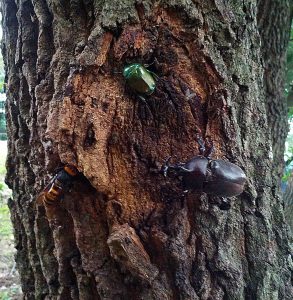Ingredients of sap from oak trees

Although the importance of the sap for the insects is well-known, it is not famous what does the sap consist of. Some people were aware that the sap contained not only sugar but protein (please see another post). However, I could not find a literature that listed ingredients of the sap.
The ingredients were reported in a book
Recently I found what I was looking for. The book “樹液をめぐる昆虫たち(Insects over sap)” shows the ingredients of the sap. The book aims at children, but contains original research done by the author or academic researchers. For the sap ingredient, the author sent sap to a researcher and asked him for analysis.

The sap is composed of sugars, protein, and fermentation products. The fermentation products include ethanol, glycerin, acetic acid etc. (for the complete recipe including percentage, please refer to the book).
Natural and artificial saps
It reminded me artificial saps or traps that have long been used by amateurs. No one knows the actual ingredients of the sap before this book, but those items partially imitated the ingredient of the real sap.
Recipe 1 – artificial sap (seen in books in 1980’s)
Mix and boil brown sugar, water, sake and vinegar.
I suppose someone simply tried to imitate the sap. Probably he or she recognized ethanol and acetic acid in the sap by smelling, and applied sake and vinegar as available sources of those two ingredients.
Recipe 2 – banana trap (I do not know when this started, but I knew it in 1990’s)
Mix cut-banana, distilled spirits (shochu), dry-yeast and sugar. Leave it for hours and then set it on a tree.
This is so-called “banana trap” and is used to attract rhinoceros beetles and stag beetles in wild. The process “Leave it for hours ” is important to promote fermentation.
The recipe would be effective because of two reasons: 1) volatile fermentation products attract wide range of insects, and 2) The effect lasts for several days because the fermentation continues on the ingredients.
What’s next?
We can make a “perfect artificial sap” that completely imitate the ingredients of the natural sap if we refer to the ingredients list in the book. However, I suppose this is not reasonable. Nowadays commercial jellies contain enough nutrients for breeding purpose. “Banana trap” is enough for insect collecting purpose. More than anything, the “perfect artificial sap” would be time and cost consuming.
Starting from the sap ingredients list, I hope some suppliers or amateurs develop new concept jellies. I put my expectations here…
- A jelly that avoids fruit flies
- A jelly that enables the insects more healthy
- A jelly that is customized for breeding minor species